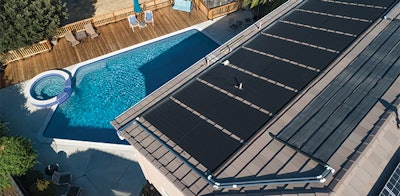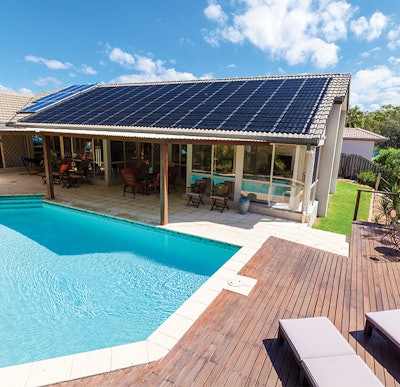
Solar thermal — they're two words that you've likely come across time and again. Conservationists love it. People who enjoy extended swimming seasons love it. Solar thermal is a reliable, environmentally friendly and affordable alternative to gas or electric pool heaters. In fact, it's one of the easiest and most inexpensive ways to use solar energy. But for as simple as the concept might seem, there's complexity behind every step from system design and installation to service. AQUA reached out to a few professionals in the industry to better understand the ins and outs of using the sun's energy to heat a pool.
DEALING WITH DESIGN
The overall design of the system itself is pretty straightforward from a consumer standpoint — pool water is pumped through a solar thermal collector before circling back. But the process of making a design for the unique needs of a customer's home is quite the opposite. Bryan Raymond, president of Diablo Solar Services in Martinez, Calif., explains the details of what goes into each decision.
"First we talk to the pool owner to determine why they're looking into solar and how they want to use their pool," says Raymond. "When do they want to use it? What months, what times of the day? What temperature pool water do they enjoy?"
One pool owner might prefer their pool to be in the mid to high 70s if they're using it for exercise. Others refuse to get in a pool unless it's 85 or higher. Most children will swim in a pool regardless of the temperature, but their parents might think very differently. All of these factors go into optimizing the design for a particular customer.
Once the customer's needs are determined, a system is designed to meet them. This includes measuring the pool's surface area to take heat loss into account, noting whether the pool is shaded (a shaded pool is more difficult to heat and calls for a larger system with extra paneling), if the pool has a cover, determining if any current pool equipment will need to be updated or replaced for proper operation of the new system and of course, the location for the solar installation.
RELATED: Putting the "Hot" in Hot Tub
"Most solar pool heating systems are installed on the roof," says Raymond, "but some can be installed on ground-based racks, pergolas, patio covers, carports and sometimes even sheds or barns."
Since the majority of customers end up going with a roof installation, that area becomes the next focus — its amount of shade, pitch and material. An important consideration is how the panels will be secured without compromising the roof.
For PWR, a solar company based in Escondido, Calif., determining the design consists of taking measurements before using standoffs and railings that attach the panels, which avoids overall contact with the roof. This approach limits the roof penetration and assures that all their work is done according to roofing standards, which is reassuring for a customer who might be concerned about the possibility of damage or leaks.
Besides roof integrity, other roof challenges may loom at this point, including what Phil DelNegro, vice president of sales and marketing at FAFCO, calls the "battle of the roof space" between electrical power needs and pool heating needs.
"When people don't heat their pool currently, it's usually because it's too expensive," DelNegro says. "They heat it because of luxury, so if you have the choice between putting a solar thermal product on your roof or a solar electricity product to eliminate your electric bill, you're going to eliminate the electric bill."
With limited space on the roof, a customer installing solar for the first time may have to choose between one or the other. FAFCO now offers a solution for this dilemma in the form of CoolPV — a solar panel that generates both electricity and heated water.
"We believe that's the future trend," Del Negro says. "Not having to choose is always a great option to offer customers."
Once every considerable design detail has been taken into account from purpose to placement, a proposal can be created by the company which is then approved by the customer. After this is completed, installation can begin.

THE INSTALLATION PROCESS
When it's all boiled down, the installation process typically revolves around four main things: roof integrity, layout, plumbing size and proper pump size. That may sound simple, but there are a few basic precautions that Gabriel Erbe, president of Pure PWR Pools, recommends be taken for each installation.
"You have to make sure you have proper water flow through the panels," says Erbe. "This will make the system as efficient as possible and less taxing on the pool equipment. To make sure you're not taxing the pump, you have to assure the pump is sized properly and that the plumbing is sized properly. If you're not getting proper drain down, then you start to worry about winterization and freezing issues."
RELATED: Gas Pool Heat Banned
A common issue both Raymond and Erbe have noticed is that new installers often don't understand the amount of time and attention needed to ensure system quality and integrity. When shortcuts are taken or steps are overlooked, it makes for a poorly installed system, one that doesn't allow an even flow of water and creates a heated pool's worst nightmare — cold spots. It's a problem that can stay hidden for some time, and from which it's difficult to recover.
"Once the solar panels are installed, unless the panels are leaking water, it's almost impossible to determine if the water is flowing correctly," Raymond says. "The installer won't know there is a problem until they get that angry call from the pool owner."
As Raymond notes, installing solar thermal is a complex profession that takes years to learn, but a major key to success is as simple as it sounds: take your time; know your stuff.
KEEPING UP WITH CUSTOMERS
An understandable fear that companies might have is also one of the most appealing features of solar for a consumer — the low, seemingly non-existent maintenance of its design. Solar is not only made to have a longer life than a gas or electric heater, but tends to require less service, too. However, just because the product becomes a quieter part of a customer's life doesn't mean it's a one-and-done installation. Check ups and repairs are just as crucial for solar thermal as any other product, if not more.
"After you get around the three-year mark, it's a good idea to start having yearly maintenance," says Erbe. "Get up there, take a look and make sure there's nothing happening, because pool solar is a moving piece of equipment. It's expanding and contracting on a daily basis, so there are a lot of things that can go on. You want to make sure that's being looked at so that a small issue doesn't turn into a large issue."
And in terms of necessary visits to make sure the system is powered properly and turned off the same, the need for service becomes even more frequent.
"We visit customer's homes at least twice per year," Raymond says. "Once in the spring to start up their pool solar system, and again in the fall to shut it down prior to the freezing temperatures in winter."
RELATED: Pentair Earns 2019 Energy Star Partner of the Year
Raymond continues to emphasize just how important it is to shut down and drain the panels once it's no longer being used for the season, no matter who the manufacturer is or what the product's warranty might claim. Not doing so could result in increased expansion and contraction of the solar tubes, causing them to be brittle and more susceptible to leakage.
"It's just like changing the oil in your car or cleaning the leaves out of your gutters," he adds. "You need some basic and preventative maintenance to make sure that your investment lasts as long as possible."
The service doesn't stop there, either. For PWR, working on the support side of solar gives them new opportunities to provide equipment repair as well, from putting in new pumps, filters, heaters, automation and more, which figure into the bottom line.
"Solar is a very profitable product," DelNegro adds. "Its serviceable life is pretty long, but the benefit of that is that you're going to sell someone a warm pool, and in the pool business, you want people swimming longer so they can buy other things. If you want to make money long term and be a long-term thinker, sell warm water; sell warm pools. The result is that you'll have happier customers that buy more products from you."
DelNegro says the average lifespan of solar thermal equipment ranges easily between 12 and 20 years, and he's never surprised to learn when a system surpasses 30 or even 40. In a span of time like that, Erbe and Raymond both encounter a range of service opportunities. Leaks can usually be repaired to offer the product a longer life, system and roof inspections make for a more confident customer, and occasionally someone will need their panelling removed and reinstalled due to roofing issues. Staying with the same people for so long is all the more reason they both approach their business in terms of the service they provide.

AND THE MOST IMPORTANT THING...
Out of all the aspects to consider when thinking about solar thermal, the most important thing is to make sure it's being done right. And to do this, it's important to do your homework.
"Understanding solar is the first step," says Erbe. "When people get into something without a full understanding of it, they start having customers complaining, saying 'hey this isn't working', and they're running around trying to fix what wasn't installed properly the first time. I think proper training, understanding design and then understanding pricing are most important when it comes to solar. If you can put those items together, you can have a successful business in any field."
"Solar thermal really isn't something that contractors can just decide to do," Raymond adds. "It requires years and years of real-world and on-site experience to guarantee that water will flow at the proper rate through all of the solar tubes in all of the solar panels."
RELATED: Rising With the Sun
So as more customers decide to make the change to using solar technology for heating their pool, it's reasonable to wonder what the growing incentive is; whether it's environmental, financial, or maybe just the idea of an extended swimming season and a sleek system on the roof is enough for people to make the switch. For solar thermal professionals, though, it's about using their extensive knowledge to provide a quality system through exceptional service. And for others, the appeal might not even be in the product at all.
"When people today consider solar thermal or any type of solar, it's really a way of thinking rather than a product," says DelNegro. "It's not like chlorine or a swimming pool pump where people just place an order. It's a conceptual kind of thing — and it's pretty powerful."











































